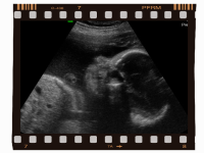3D AND 4D ULTRASOUND - UNDERSTANDING THE TECHNOLOGY
It's a huge mystery for expectant moms - waiting nine months without getting to see what's going on inside you. Recent advances in ultrasound technology can now allow expectant families to bond with their babies before birth. This technology, known as 3D or 4D ultrasound, provides a new, clearer window into their baby's world.
HOW DOES IT WORK ??An ultrasound is the interpretation of reflected sound waves to form a picture of the fetus. 2D ultrasound (sometimes referred to as "traditional" ultrasound) has been safely used in obstetrics for over 35 years. 2D ultrasound works by “listening” to sound waves in a single plain. The ultrasound is directed straight down and reflected back up again. Think of it as being able to virtually slice a loaf of bread. The resulting black and white image is similar to looking at the face of a slice of bread.
3D ultrasounds work by a different process known as "surface rendering". In this case, the same sound waves used in 2D are sent down – this time in different angles. These reflections are interpreted through sophisticated software, and a 3D image of the fetus is instantly created. Using the same "bread" analogy as before, the surface of the loaf is now being examined from the outside. Surface details can now be visualized with remarkable clarity. 4D ultrasound is captured in the same manner as 3D ultrasound. Instead of looking at a single still image (3D), you are now able to view live “video” of the fetus in the womb (4D). THE CONCERNSMany 3D/4D ultrasound centers have recently opened, providing affordable elective ultrasounds to expectant families. This has drawn criticism from several organizations. But if the equipment is regulated, and the practice of ultrasound for prenatal care has a good safety record … where’s the problem?
Some doctors are concerned that their patients will opt to get too many unnecessary ultrasounds. But if the argument of ultrasound safety was simply based on overall exposure, then a good follow-up question would be: “If increased ultrasound exposure is a cause for concern, then why do higher-risk pregnancies typically receive so many?” Other doctors are understandably concerned that mothers will use these elective ultrasounds in lieu of an ultrasound prescribed by their physicians. They are also concerned that a technician may try to present diagnostic information that should only be interpreted by a board-certified physician. An elective ultrasound should only be used to complement the ultrasound sessions prescribed by a physician. A full-anatomical study should always be completed first to identify any potential prenatal issues. The parents-to-be can then utilize the elective session as an insightful, bonding experience. THE POSITIVE IMPACTS OF BONDING
Expectant mothers nationwide are seeking elective ultrasounds because they feel it will have a positive impact during their pregnancy. Recent studies have shown that viewing an ultrasound can cause marked improvement in maternal health habits. Studies presented at an American Institute of Ultrasound in Medicine (AIUM) meeting have even supported that 3D ultrasounds will positively influence parents bond with their babies.
Mothers tend to improve their diets, exercise more, and eliminate harmful behaviors such as smoking or drinking. Other ultrasound benefits may also include increased paternal involvement, family support, empathy, and appreciation. FINDING A RESPONSIBLE ULTRASOUND PROVIDER
Although there are plenty of entertaining aspects to a 3D/4D ultrasound, safety and professionalism should always remain paramount when choosing a provider. A responsible ultrasound provider will require proof that the client is seeing a healthcare provider for prenatal care. Proof should also be required that the mother-to-be has already completed a full-anatomical, second-trimester ultrasound study.
The provider should use the system’s obstetric mode to keep within FDA-established levels for frequency and power for prenatal use. They should also limit the actual scan time to less than 25 minutes per session. A session must be immediately suspended if anything adverse is discovered, and all findings should be directly reported to the mother’s healthcare provider. Remember that word-of-mouth is usually the best method of referral amongst expectant mothers. Many sonographers and technicians tend to forget that this is a special moment during a mother’s pregnancy. So do your homework, and ask around. The best ultrasound experience will be the culmination of the nicest facility, the best equipment, and a professional, caring staff. |

